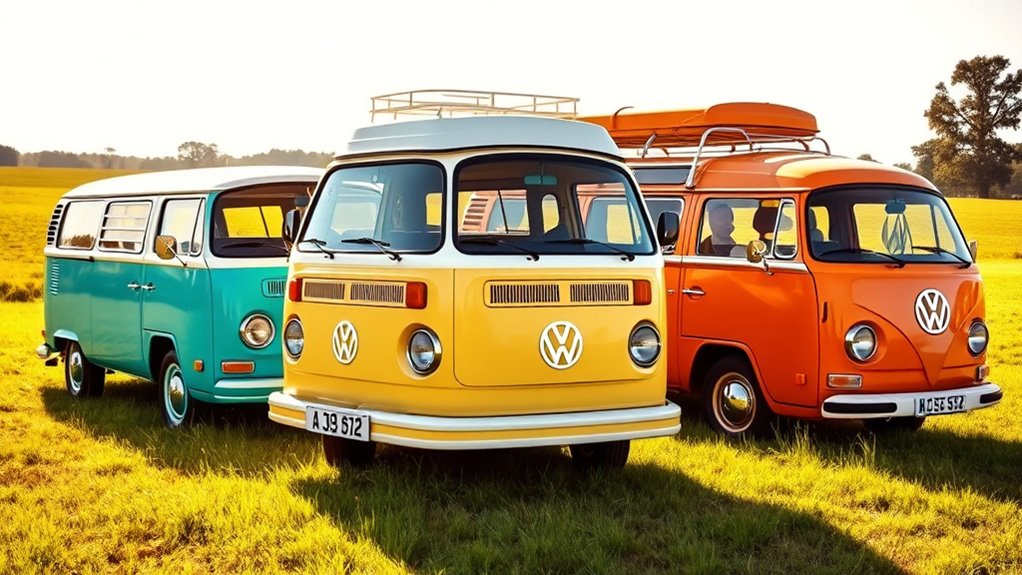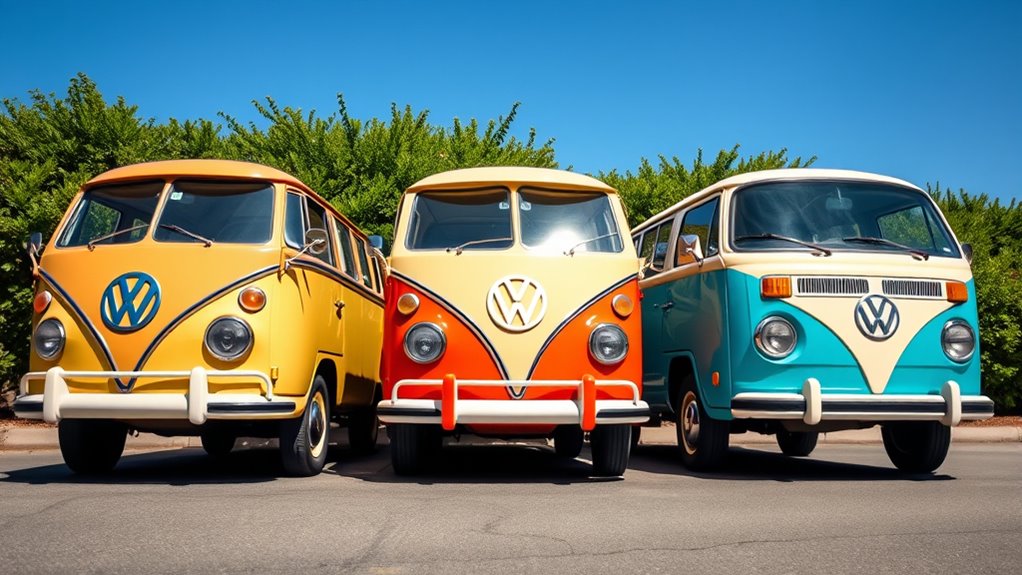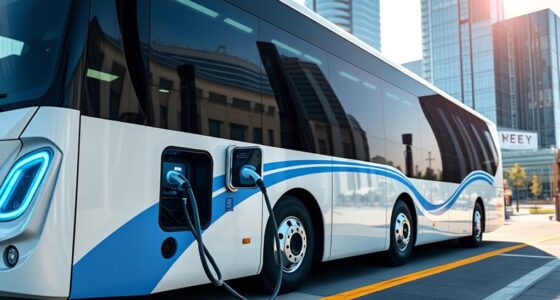If you’re exploring the VW Bus’s history, you’ll find it spans several key generations, each with unique styles and features. The first, known as the T1 or “Splitty,” offers vintage charm with its split windshield. Next comes the rounded T2, and later the boxy T3, each improving comfort and design. Understanding these differences helps you appreciate their custom potential and guides your restoration or modifications. Keep exploring to uncover the details that make each era special.
Key Takeaways
- The VW Bus has three main generations: T1 (“Splitty”), T2, and T3, each with unique design and features.
- T1 is the original vintage model with a split windshield, popular for restoration and customization.
- T2, produced from the late 1960s to 1970s, offers rounded styling and improved mechanical options.
- T3, from the 1980s to 1990s, features a boxier shape, modern safety, and mechanical upgrades.
- Understanding each generation helps enthusiasts restore, modify, and appreciate the VW Bus’s legacy.

Have you ever wondered what makes the VW Bus an enduring icon? Its timeless design, cultural significance, and versatility keep it popular among enthusiasts and newcomers alike. Whether you’re restoring an old model or customizing one to suit your style, understanding the different Volkswagen Bus generations is essential. Each era offers unique features, engineering styles, and potential for modifications. Knowing these details helps you appreciate what makes each version special and guides you in your restoration or custom build journey.
Starting with the first generation, the Type 2 T1, introduced in the late 1940s, is often called the “Splitty” because of its distinctive split windshield. This vintage classic is highly sought after for restoration tips, especially since many models have aged and need significant work. Restoring a T1 requires attention to rust and structural integrity, as well as sourcing authentic parts to preserve its heritage. When considering custom modifications, however, many owners choose to add modern amenities or engine upgrades while maintaining the original charm. The T1’s simple design makes it easier to modify without losing its classic appeal, giving you the opportunity to blend vintage aesthetics with contemporary comforts.
The VW Type 2 T1, or Splitty, is a vintage icon perfect for restoration and modern customization.
Moving into the second generation, the Type 2 T2, produced from the late 1960s to the late 1970s, introduces a more rounded shape and improved engine options. Its design appeals to those seeking a balance between classic looks and more modern conveniences. Restoration tips for the T2 often involve upgrading the suspension, replacing rusted panels, and restoring the interior to its original state. If you’re into custom modifications, the T2 provides plenty of room for creativity — from installing custom paint jobs and interior setups to swapping engines for more power or efficiency. Its larger size and more contemporary features make it a great platform for personalization.
The third major era, the Type 2 T3, produced from the early 1980s to the late 1990s, has a boxier appearance and improved safety features. Restoring a T3 often means addressing more complex mechanical systems, but it also offers opportunities to upgrade with modern parts for better reliability. When customizing a T3, you can opt for performance enhancements or aesthetic tweaks, such as lowering the suspension or installing aftermarket wheels. The T3’s sturdiness and spacious interior make it ideal for those wanting a versatile vehicle that can serve as both a daily driver and a showpiece. Additionally, the T3’s recognition as a biodiversity-friendly vehicle emphasizes its potential for eco-friendly modifications.
Understanding the different VW Bus generations enables you to make informed decisions about restoration tips and custom modifications. Whether you’re aiming for a vintage look or a modernized, personalized ride, knowing the strengths and quirks of each era helps you craft a vehicle that stands out while honoring its iconic history. The VW Bus’s enduring appeal lies in its ability to adapt to your vision, making it a truly customizable classic for generations to come.
Frequently Asked Questions
What Are the Main Differences Between Type 2 and Type 3 VW Buses?
You’ll notice that Type 2 buses have a rear-engine placement, giving a spacious interior with a flat floor, ideal for customization. In contrast, Type 3 buses feature a front-engine layout, resulting in more compact interior space but easier engine access. The interior layout differs markedly, with Type 2 offering versatile configurations, while Type 3 emphasizes a smoother ride and unique styling. These differences shape your experience, whether you prioritize space or ease of maintenance.
How Reliable Are Vintage VW Buses for Daily Driving?
You’ll find vintage VW buses can be charming, but engine reliability varies. For daily usability, expect regular maintenance and tune-ups to keep them running smoothly. Older engines might need frequent repairs, so don’t rely on them for long daily commutes without some prep. If you prioritize reliability, consider upgrading parts or choosing models with better engine histories. With proper care, your vintage VW bus can be a fun, nostalgic daily driver.
What Are Common Restoration Challenges for Classic VW Buses?
You’ll face common restoration challenges like rust repair, especially in the floors and frame, which can be time-consuming and costly. Upgrading the engine for better performance may also be necessary, but it requires careful planning and compatibility checks. Expect to spend effort on sourcing original parts or quality replacements, and be prepared for some trial and error to get everything running smoothly. Patience and attention to detail are key.
Which VW Bus Models Are the Most Collectible Today?
Imagine holding a piece of history in your hands. The early Westfalia and Samba models are highly collectible today, thanks to rare model features like unique paint and original interiors that excite collectors. These vintage VW buses are like rare gems in the collector’s market, often fetching top dollar. If you find one in good condition, it’s a smart investment that captures the spirit of the 60s and 70s.
How Do I Identify the Production Year of a Volkswagen Bus?
To identify your Volkswagen bus’s production year, start with VIN decoding, which reveals detailed info about the build date. Check the VIN plate usually located on the dashboard or driver’s side door frame. Additionally, look at body style identification features like the shape of the windows, headlights, and body contours. Combining these clues helps you accurately determine the production year of your VW bus.
Conclusion
Now that you know the different Volkswagen Bus generations, you’re ready to set out on your own vintage adventure. Whether you choose the classic Type 2 or the modern T6, each bus has its unique charm and story. Imagine yourself cruising down the highway in a timeless icon that’s as legendary as the open road itself. With this knowledge, you’re basically a VW Bus expert—ready to turn heads and make memories in a vehicle that’s truly a rolling piece of history.









